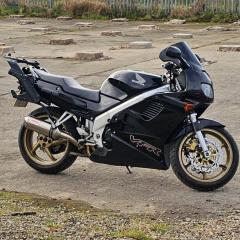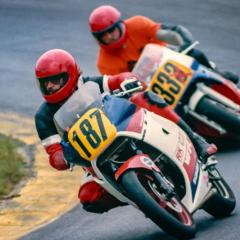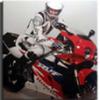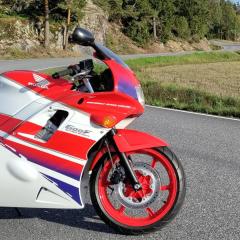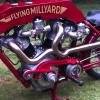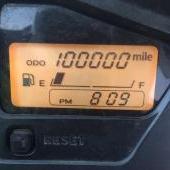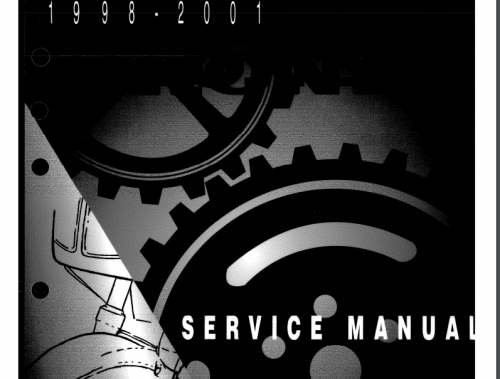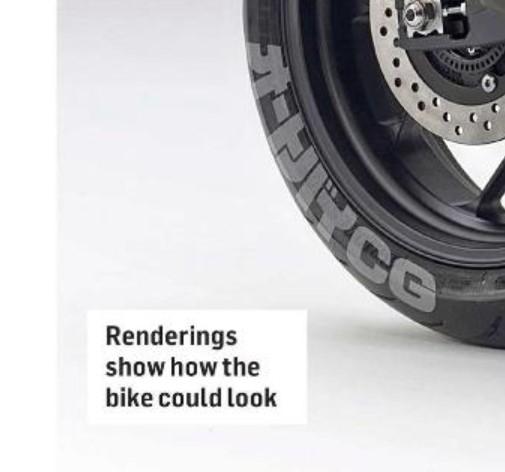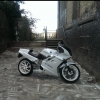Leaderboard
Popular Content
Showing content with the highest reputation on 02/27/2024 in all areas
-
4 points
-
Well, time goes on, still dont have a VFR but after haveing to sell a lovely Africa Twin fall/autum 2021 becouse sudden payments came around the corner (read divorce early same year) a few pics of the Africa Twin 750, model 95 So wanted a same kinda bike in spring 2022, so buoght a old cheap Transalp 600, 87 model, that a passed away fathers son sold, father had owned it for almost 15 years... It was tatty, but didn´t care of looks, it did run good, so planed to just ride it the summer or 2 and pass on as I have funds for a other Africa Twin....... It had a few issues, forks where leaking, front brake was weak from the fork oil that had com on brake pads as disc.... small fixes I tought..... Got myself new brake pads as fork seals, but it needed more that just brake pads Belive it or not, the pistons in that calipper moved freely! To order more parts.....1 point
-
1 point
-
If I were betting, I'd blame the dealership for doing something stupid before I'd blame Honda.1 point
-
Maybe put DOWN the lighter. You want to work with the drugs, not against them.1 point
-
1 point
-
I would take another hit with that lighter, chill out with a finger of bourbon and look at my killer bike with it's new custom Volt Meter.1 point
-
1 point
-
1 point
-
1 point
-
Understanding how an air box works and the reasons why a stock box is a safer bet... If you have ever had the gas tank off your late-model sportbike, you will notice that the front of the fuel tank doesn’t hold fuel; it holds an airbox. In the old days, when you bought a new bike, it had an air-filter case attached to feed the carburetors or the fuel-injection intakes. All the sharp, young guys would immediately rip off the filter case and replace it with four sock filters. Reduced airflow resistance. Much better performance. One day in the late 1980s, they began to rip off the airboxes of their new bikes and their engines fell on their faces. They lost a bunch of performance. “This can’t be happening! Putting on sock filters always worked before.” But it turns out the industry found a way to boost performance by making what is known as a resonant airbox. We have all in an idle moment blown across the mouth of a beer bottle and heard the "whoooo" of the bottle resonance. As air goes across the mouth of the bottle, it creates a low pressure, which causes air to flow up. That deflects the air away from the mouth of the bottle. Then the air goes back in, the airflow from your mouth goes back across, and the cycle repeats, rapidly fluttering and producing that deep tone. The compressible air in the bottle is acting as a spring, and the slug of air in the neck of the bottle is the mass that vibrates against that spring. This intake airbox from a fuel injected Honda is just a glorified beer bottle. Instead of the engine blowing across the mouth of it, its four throttle bodies are sucking from the box, pulling its pressure down. Air rushes in through the ducts in the fairing to fill up that low pressure. The next cylinder sucks the bottle pressure down and more air rushes in and restores the pressure. If the volume of the box and the mass of the air in the intake pipes are correctly chosen, the box will hum like the beer bottle. The trick is to get your engine to draw air from the box when the pressure is up and then the box refills when the pressure is down. And that is why ripping the airboxes off and putting on old-time sock filters resulted in a reduction in performance. In a specific zone of rpm, a resonant airbox can boost your engine’s torque by 10 percent. That’s worth having! My friend Stephen called long distance from England because he just installed a $900.00 HRC air box on his RC45 and saw 120HP on the dyno... mmmmm... together we wondered if the stock box be modified??? We found that stock RC45 throttle bodies are 46mm but the air box was restricted to 40mm... no problem... I'll bore the air box out to 47mm on the milling machine... I drew up plans for 47mm bell mouth based on the stock 40mm bell mouths and purchased a block of black Delrin... I'm not happy doing repetitious work but I labored long hours to machine 4 each bell mouths with my best accuracy... Don't you love when a plan comes together especially if it turns out perfect??? Now I had an unrestricted air box with my own 47mm bell mouths... it was the best I could do to replicate HRC $900.00 air box... not to mention I wanted to keep my home made K&N filter... Time to put the Mod to the test on the dyno... this is Dave at Chandelle Motorsports... No joy... I lost 1.8HP on the dyno... so bigger is not better in this case... a whole week worth of work shot down in flames... it seems Honda got the intake velocity right for a stock pipe after all... air boxes are like tuned instruments... alter the holes and the tune just makes sour notes and power suffers... Mr.RC45 fueling is not the problem... my air box will remain stock because our air box works like a finely tuned instrument... any wild ass guess mod disrupts this highly engineered resonant to where to you're producing nothing but sour notes... The airbox inlet tubes, or “horns”, are specifically designed to provide a resonance that can increase the total airflow by up to 10-15%. Second guessing these can cause the engine to loose power and increase the intake noise as in my case... RC45's stock intake horns are there for homologation purposes only and do not directly feed into the airbox only the HRC intakes feed ram air into the airbox...1 point
-
Version 1.0
104,757 downloads
This is the same manual that is already available here on VFRD. I have been using this so much lately that I went ahead and made it a little more useful for myself. I assumed that some other members might like to have it as well. Combined both files into one. Optimized the file size so that it is only 60 MB. Ran OCR text recognition to enable text searches on the entire book. Rotated pages that had landscape page diagram for ease of viewing. Created bookmarks for each chapter & sub-chapters. I figured this was the least I could do to contribute since I am getting so much help from this forum.1 point -
1 point
-
1 point
-
Well my name is probably a clue. Just more bullshit on the same bike and nothing "improves" it. Give me Fuel Injection, that's fine. But I'll stick with just a analog high idle lever thank you. Keep your stupid "wax unit", I've been on the end of a "choke" lever my whole adult life. I think I can handle it. Sure the exhaust is just mild steel. That's fine, I don't ride in salt water, and I'll get it coated. But you can keep your catalytic converter (and associated hardware, software), even if it is made out of stainless. Besides the stupid Linked Brakes (yes, yes... I know the system works great, I've ridden plenty), the 98-99 is as close to a pure "modern" (re: FI) gear driven cam VFR you can get. Linked brakes, with secondary masters, proportioning valves and 2 miles of hose, belong on a fucking Gold Wing,1 point
-
Hey all Unsure if this has been covered in detail. I thought it'd be useful to put a picture guide together for removing and rebuilding the calipers on the RC36 VFR750 (1989 to 1997). This process should be identical throughout the RC36 models as the calipers never changed (to my knowledge!) Keeping your calipers in good shape is important for obvious reasons. You want to stop the bike as effectively as possible. There are a plethora of complaints about this bikes stopping abilities. I really, truly believe the sliding calipers are more than enough for this bike as long as they're in good nick. Out of shape calipers can cause other issues, pistons seizing leads to uneven pad wear, which in turn will result in warped discs. An expensive and arsehole job you really don't want to be getting involved with, which usually leads to going to a garage and paying labour costs and over inflated prices on discs. Fresh seals, removal of rust and dirt from the slider pins and new pads will see this bike locking up a fully warmed up PR4 with absolute ease. On a side note, the other thing that affects the bikes ability to stop is the state of the front fork oil. But we'll get back to that one in another guide! Before you do this, read the WHOLE guide so you get a feel of what you need in advance. Ok so to start, you need the following: Patience 12mm Socket 8mm spanner Torque wrench (1/4" drive is best) Rags Plastic zip bags Allen keys Thick, wide flat head screw driver Brake cleaner Copper grease Red rubber grease Brake fluid (dot4)R replacement seal kit for both calipers Ok so here goes! 1. Prop the bike up. Centre stand, ABBA stand etc...just get it upright. 2. Remove the Pad retaining pin cover. *WARNING* this thing is a piece of sh*t, it can and WILL round off and be an arse to remove. I highly recommend you carefully select a fat, wide flat head screw driver tip and gently apply more pressure when trying to turn it. If you get the SLIGHTEST hint of the blade digging into the cover's metal, stop. Buy some decent penetrating fluid (WD40 fast action release is good) and douse it, leave it overnight and try again the next day. If it's truly stuck, try an impact screwdriver or just drill the bast*rd out. 3. Remove the pad retaining pin 4. Remove the pads by giving them a tug if they don't fall out 5. Remove the Caliper retaining bolts (12mm) 6. Remove the calipers 7. Place a piece of wood or something similar between the pistons and the inside of the caliper. The idea is to pump the brake lever until the calipers are MOST of the way out, so choose your piece of wood (etc) carefully. I actually used a plastic box that holds my digital measuring calipers! This will ensure the pistons move to an even point. You want them to be about this far out (see top piston, I later evened it out by pushing the top one back in, putting the plastic case in place and pumping the lever again until they were both out the same amount.... 8. Put the calipers back in place on the forks, loosely put the bolts back in to hold them there. You may need to push the slider part of the caliper out a bit to make enough space. Don't worry if the slider comes off the caliper, it just pops right back on. 9. Place a rag under/around the caliper, specifically near the brake line banjo bolt (as you'll be removing this and will want to soak up the excess fluid. It EATS paint, don't wanna ruin your wheels...right?) 10. Use a 12mm socket to crack off the banjo bolt 11. Make sure to hold the rag tactically to soak up the drips. Remove the brake line..try to leave the bolt and washers in place for ease purposes. Slide them back through the brake line etc if anything falls off. 12. Immediately slide a plastic zip bag over the brake line. This will allow you to leave it dangling while you work on the calipers. *WARNING* keep the calipers upright so the hole that the bolt went into for the brake line is facing the sky. You'll spill fluid everywhere otherwise as it sits in the caliper. Pour it into a bucket etc by turning the caliper upside down. 13. By the point the calipers will be off the bike and your hands will be all slimey, give them a wipe (your hands and the calipers!) 14. Pull the sliders off the caliper. You'll be left with the below 15. Get a rag, drop it over the pistons. Use some mole grips/strong pliers to grip the pistons over the rag and pull them out. Depending how badly seized your pistons are, you may need to use an airline in the banjo bolt hole to blast them out. Be patient and don't lose your cool, jump in the car and take them to a garage to blow 'em out if needed! Now you'll be left with two empty calipers that are still dribbling fluid, just mop it up as best you can. If you think your calipers are clean...think again, they'll likely have rust on the sliding pins and or some horrible poo looking gunk in the piston holes. My bike has 25000 miles, has been incredibly pampered it's entire life (the service history folder weight about 5kg). Look at the different between one slider and the other, look at the gunk in the piston holes and on the piston itself. I flush my fluids every 3 months (excessive I know) and it still gets like this! I've put my pistons in Paraffin so they can soak overnight to make removing the stuck on crap easier. You can get away with using super fine sandpaper to remove anything jammed on, but why ruin that nice smooth surface? Next thing is to clean the calipers up and replace the seals. 15. Clean all gunk, muck and poo from the inside of the piston holes and the surfaces of the calipers. I used a mixture of old cloths, brake cleaner and paraffin. As you can see above, my calipers were super mucky, all that brown shit was old brake fluid, that's what happens when you ride all year and leave it laid up for a while, this bike was off the road for five years before I purchased it! I went from this: To this (top caliper is the clean one, bottom caliper was done shortly after) : I had to use a very slim screwdriver with a cloth over the end to jam in the brake line hole, it had brown poo in there as well. It was so hard to shift that I ended up using one tin of brake cleaner per caliper! 16. Next remove the seals, thin ones higher up the piston hole, bigger one further down. I used the same small screwdriver to remove these. They can be a pig so have a scalpel/something sharp to hand s you can stab and drag it out if it gets stuck The muck under the seals was pretty bad too. It works it's way past the seals over the years Use the same small screwdriver or a tooth pick to scrape out as much of that crap as you can, you'll never get it all out unless you have an ultrasonic cleaning bath with some serious cleaning solution 17. Once cleaned, replace the seals with new ones or reuse yours if they're in good condition. I smother mine in red rubber grease before they go back into the slots. 18. Now replace the rubber boots. The one on the slider part is easy to pull out. Give it a clean in there with brake cleaner, rag and screwdriver if needed. Replace the boot with a new one or reuse if in good nick The caliper rubber boot is...awkward. It requires a lot of squeezing the end and tugging, It might split if in poor condition so make sure you have a replacement if needed, might be worth checking this in advance 19. Clean up your pistons and place them back into the piston holes. They can be fiddly so have a c-clamp on hand if they won't go into place. Again, I coat these in red rubber grease, it just helps the sliding action, is brake fluid friendly and keeps things from seizing for much longer 20. At this point I remove the bleed nipple and blast it with brake cleaner, both outside and jam the brake cleaner tube into the nipple hole and blast it out (watch your eyes, seriously!) I then coat this in red rubber grease and put it back in place 21. Cover the sliding pins in red rubber grease, I previously assume coper slip was fine but it seems I was wrong. Grease on the pins keeps them from rusting and assures they take an age before needing another clean (Thanks to Steve27bha for the above pic) 22. I now put the brackets back in place, they only go in one way so won't bother with a pic (forgot to take one anyway) 23, Out the slider back onto the caliper body, again these only go in one way so don't worry about what goes where 24. Brake pads now go back in place. I clean up the retaining pin with some wet and dry, feel free to coat it in copper grease to protect it from the elements 25. The brakes are now back together and ready to go on the bike, bolt them in place 26. Get a rag and wrap it around the base of the caliper, take the brake line out the plastic bag and put it back on the caliper, a washer sits at both the bolt head and under the brake line 27. Torque everything up (low range torque wrench should be in the region of £25): Mounting bolts: 27nm Banjo bolt for the brake line: 35nm Bleed nipple: 17nm 28: bleed the system, wrap a rag around the master cylinder. Use a number 2 philips screwdriver/bit and remove the lid screws. Gently prize out the plastic cover and remove the rubber reservoir fill. Turn the wheel to the left if on a stand to level out the reservoir (Careful does it, don't spill anything as brake fluid eats paint remember) Get an 8mm circle spanner, put it over the bleed nipple - either caliper is fine. Some say do the one furthest away from the caliper first but I've found it makes no difference on these calipers. It does, however, on normal 2/4/6 pot calipers with no slider in my experience Buy a one way bleed valve. Halfords sell these for £9.99 http://www.halfords.com/motoring-travel/motorcycling/motorcycle-accessories/gtmoto-brake-bleeder Stick the spaner over the bleed nipple bolt Dab red rubber grease around the nipple to stop air inducing into the system Put the thin tube of the brake bleed kit over the nipple, the valve has an arrow on it that should be pointing away from the nipple/caliper. It's one way so stops air going back up the tube. Now at this point your system will be all air and little fluid. So you WILL need to employ a traditional method of getting fluid through the lines and into the caliper (keep a bottle of dot four handy to top the reservoir up, don't let it empty of you'll induce air into the system and have to start all over again): with the bleed nipple closed, pump the lever slowly four times, hold the level all the way in open the bleed nipple with your other hand (this is why a circle spanner is handy rather than an open ended one as it stays in place) you only want to open the nipple a small amount. Still holding the Brake lever in, close the nipple Repeat the above steps until fluid starts to make it's way out the tube. It took me about 4 sets of 4 pumps. As long as everything is torqued correctly, it should be the same for you too. Once fluid comes through, you can leave the nipple open for longer but will still need to close it from time to time to pump the lever four times (and hold it) to force air out the system. This induces pressure in the system. Once the fluid comes out clear with no bubbles, move onto the other caliper. The second caliper is never as hard as most air is forced out the first caliper and fluid starts to spread evenly, Keeping a rag handy to quickly clean up spillage... Once you're happy with the pressure on the lever (should stop about half way from fully disengaged to pulling it to the handlebar) fill the reservoir up until the fluid it just above the viewing glass. Now put the rubber filler back in place, then the plastic cover then the metal lid (the writing on the metal lid should face you) Arguably you're done at this point. But roll the bike forward and press the brake. Careful not to drop your pride and joy - the bike should stop hard and the front dive a little. You may find the brakes are a bit faded at first, take it for a slow spin around the blocks and progressively press the lever harder and harder until the bite feels great. If it simply won't bite hard you can check the following: Pads for grease.dirt - clean with brake cleaner System for air - bleed again until satisfied Worst case scenario you may have a master cylinder that needs a rebuild, having a seized piston can mask this and make the brakes feel super tight and strong. Cleaning them up and freeing the pistons up to move evenly can show your system to be a bit spongey as everything moves back to positions as it should, rather than one piston staying 3/4 the way out while one backs off - or the slider being stuck as a certain point. Hope this makes sense. I'm going to re-read this a couple of times and make alterations as I see fit. Hopefully it'll help those who're too scared to try this on their own. It's very easy as long as you're methodical about it.1 point


